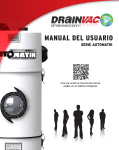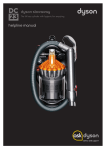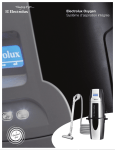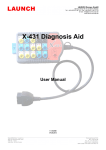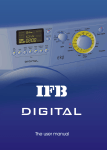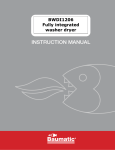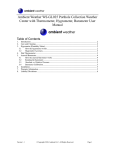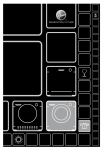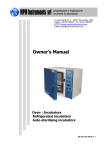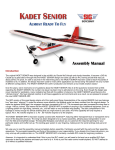Download User Manual
Transcript
OWNER’S MANUAL AUTOMATIK SERIES PRINTED IN CANADA (07-11) For an online version of this manual (readable with a smart phone) TITRE INTRODUCTION TECHNICAL PROBLEMS TITRE THE UNIT WON’T START UP... SOLUTION : We wish to thank you for your trust and congratulate you for having chosen a Drainvac product. It is a sound investment that will satisfy your vacuuming needs for years to come. The concept of Drainvac’s Automatik central vacuum cleaners is unique and patented. They are manufactured and checked at our plant by our qualified staff who have been specifically trained to this end. A number of installation and operating methods must be followed to ensure your system’s maximum performance and to avoid unnecessary service calls. Please read this manual carefully. REGISTRATION To fill in the Drainvac product registration form, go to www.drainvac.com/enregistrement WARNING Never vacuum liquid or gaseous flammable materials with your system. Never vacuum ashes with your system. Drainvac International 2006 Inc. disclaims any responsibility should you infringe upon these guidelines. 1) Check the circuit breaker in your electrical panel. 2) Check the unit’s circuit fuse/breaker. 3) Check the 24-volt circuit, as follows: Try to establish electrical contact in a wall inlet with a metal object (for example, a coin). --> If the unit starts up, the suction hose is defective. --> If the unit doesn’t start up, check to see if the 24-volt wires are properly connected to the unit. Try to establish an electrical contact between the two terminals of the 24-volt circuit on the unit with a metal object (for example, a screwdriver). --> If the unit starts up, a 24-volt wire is either cut or disconnected from one of the wall inlets. --> If the unit won’t start up after these steps, the printed circuit is defective. THE UNIT WON’T SHUT DOWN… SOLUTION : Check the 24-volt circuit as follows: Disconnect one of the two wires on the unit’s 24-volt circuit. --> If the unit shuts down, the problem could be that two 24-volt wires are touching themselves somewhere or that the wall inlet is defective. --> If the unit doesn’t shut down, the printed circuit is defective. Unplug the power cord. If you wish to speak with a customer service representative, contact your supplier or: Drainvac International inc. From Monday to Friday, between 9 AM and 4 PM, eastern standard time (UTC-5) T : 1 800 408-1448 • 450 467-1448 F : 1 877 408-2225 • 450 467-2225 [email protected] • www.drainvac.com 150, Brunet street, Mont-St-Hilaire, Qc, J3G 4S6, Canada www.youtube.com/drainvacchannel www.facebook.com/drainvac 2 35 MAINTENANCE PROCEDURES TITRE TABLE OF CONTENTS TITRE MOTOR BRUSHES HOW THE SYSTEM WORKS Any mechanical system requires a minimum of maintenance and your system is no exception to the rule. We therefore recommend that you inspect your motor brushes after 500 hours of use to check how worn they are and replace them if need be. On average, this inspection should occur: • For residential applications: once every 3 to 5 years • For commercial applications: once or twice a year When the time comes, contact your retailer or distributor for this maintenance procedure. WEEE GUIDELINES This unit complies with the WEEE (Waste Electrical and Electronic Equipment) Guidelines, which promote the recycling of this type of waste equipment and encourage the development of products that are adapted to efficient waste reclamation at the end of their life cycle. The WEEE Guidelines stipulate that the original supplier should agree to reclaim any obsolete equipment free of charge. We recommend that you advise your supplier that you would like him to reclaim your unit when you order and replace it with a new one. Do not discard the unit with your regular garbage. The symbol representing a garbage bin on wheels on the unit’s label (Figure C) attests to this requirement. You must ensure that, at the end of its life cycle, your unit is reclaimed, treated and recycled by an authorized firm. For more information, contact your municipal waste management department. OPERATION SEQUENCE . . . . . . . . . . . . . . . . . . . . . . . . . . . . . . . . . . . . . . . . . . . . . . . . . . . . . . . . . . . . . . . . . 4-5 TYPE OF UNITS (TECHNICAL SPECIFICATIONS) . . . . . . . . . . . . . . . . . . . . . . . . . . . . . . . . . . . . . . . . . BOOSTER HEAD OPTION (TECHNICAL SPECIFICATIONS) . . . . . . . . . . . . . . . . . . . . . . . . . . . . . LOWER TANK OPTION . . . . . . . . . . . . . . . . . . . . . . . . . . . . . . . . . . . . . . . . . . . . . . . . . . . . . . . . . . . . UNIT DESCRIPTION 6 7 8 DV1A150, DF1A150 . . . . . . . . . . . . . . . . . . . . . . . . . . . . . . . . . . . . . . . . . . . . . . . . . . . . . . . . . . . . . . . . . . . . . . . . 9 DV2A310, DF2A310 . . . . . . . . . . . . . . . . . . . . . . . . . . . . . . . . . . . . . . . . . . . . . . . . . . . . . . . . . . . . . . . . . . . . . . . 10 DV2A31, DF2A31 . . . . . . . . . . . . . . . . . . . . . . . . . . . . . . . . . . . . . . . . . . . . . . . . . . . . . . . . . . . . . . . . . . . . . . . . . . 11 DV2A32, DF2A32 . . . . . . . . . . . . . . . . . . . . . . . . . . . . . . . . . . . . . . . . . . . . . . . . . . . . . . . . . . . . . . . . . . . . . . . . 12 DVDC40, DFDC40 (SERIES CONFIGURATION) . . . . . . . . . . . . . . . . . . . . . . . . . . . . . . . . . . . . . . . . . . . . . . . . 13 DVDC40, DFDC40 (PARALLEL CONFIGURATION) . . . . . . . . . . . . . . . . . . . . . . . . . . . . . . . . . . . . . . . . . . . . . 14 HOW THE MEMBRANE WORKS WHY CHANGE THIS PARAMETER? / SETTING THE EVACUATION TIMEFRAME . . . . . . . . . . . . . . . . . . . 15 INSTALLING THE UNIT FIRST THINGS FIRST . . . . . . . . . . . . . . . . . . . . . . . . . . . . . . . . . . . . . . . . . . . . . . . . . . . . . . . . . . . . . . . . . . . 16-17 STEP SEQUENCE . . . . . . . . . . . . . . . . . . . . . . . . . . . . . . . . . . . . . . . . . . . . . . . . . . . . . . . . . . . . . . . . . . . . . . 18-24 INSTALLING THE PIPING SYSTEM GENERAL INFORMATION. . . . . . . . . . . . . . . . . . . . . . . . . . . . . . . . . . . . . . . . . . . . . . . . . . . . . . . . . . . . . . . . . . 25 DIFFERENT INSTALLATION POSSIBILITIES (RESIDENTIAL AND COMMERCIAL INSTALLATION) . . . . . 26-27 EXAMPLES OF PROPER AND IMPROPER INSTALLATIONS . . . . . . . . . . . . . . . . . . . . . . . . . . . . . . . . . . 28-30 ELECTRICAL POWER SUPPLY PROCEDURE / EXAMPLES OF PROPER AND IMPROPER INSTALLATIONS . . . . . . . . . . . . . . . . . . . . . . . . 31 DIAGRAMS OF THE APPROPRIATE CONNECTIONS FOR YOUR MODEL . . . . . . . . . . . . . . . . . . . . . . . . . . 32 MAINTENANCE PROCEDURES VISUAL INSPECTION / REGULAR MAINTENANCE . . . . . . . . . . . . . . . . . . . . . . . . . . . . . . . . . . . . . . . . . . . . 33 MOTOR BRUSHES . . . . . . . . . . . . . . . . . . . . . . . . . . . . . . . . . . . . . . . . . . . . . . . . . . . . . . . . . . . . . . . . . . . . . . . . 34 WEEE GUIDELINES . . . . . . . . . . . . . . . . . . . . . . . . . . . . . . . . . . . . . . . . . . . . . . . . . . . . . . . . . . . . . . . . TECHNICAL PROBLEMS . . . . . . . . . . . . . . . . . . . . . . . . . . . . . . . . . . . . . . . . . . . . . . . . . . . . . . . . . 34 35 Figure C 34 3 HOW THE SYSTEM WORKS TITRE MAINTENANCE PROCEDURES TITRE Drainvac central vacuum cleaners are designed to vacuum both solids and liquids. The tank never has to be emptied manually since the systems are directly connected to the building’s drainpipe through which the wastewater is automatically evacuated. OPERATION SEQUENCE VISUAL INSPECTION Your Automatik system is very user friendly and we recommend a visual inspection through the porthole once a year or when needed. If you wish to clean the inside of the unit, refer to the following section “Regular Maintenance”. REGULAR MAINTENANCE Except for removing objects that could remain at the bottom of your tank (for lower tank models), the only maintenance required is cleaning the inside of the unit. To proceed, you just have to remove the porthole glass as illustrated, by pivoting it in an anti-clockwise motion using the handles. 1 2 Electrode Water Inlet The rubber hand is closed Step 1 Step 2 Unit is off. Start up: The dirt begins to be vacuumed and water flows in. Use a scouring sponge to especially clean the protective screen, the two electrodes and, if needed, the tank. A blocked protective screen could reduce the unit’s performance and dirty electrodes could not adequately send a signal to the unit to pass on to the wastewater evacuation cycle. At the same time, it is recommended to visually inspect the water inlet pipe and the rubber hand to make sure that no foreign object is obstructing the water flow. Protective Screen 4 33 ELECTRICAL POWER SUPPLY TITRE HOW THE SYSTEM WORKS TITRE DIAGRAMS OF THE APPROPRIATE CONNECTIONS FOR YOUR MODEL Electrical Panel Electrical Panel DV1A150 : 15-amp. circuit / 120v DF1A150 : 16-amp. circuit / 240v The water comes into contact with the electrodes DVDC40 : 15-amp. circuit / 120v DFDC40 : 16-amp. circuit / 240v 24-volt wires (supplied with the unit) DV1A150 / DF1A150 DVDC40 / DFDC40 Electrical Panel Electrical Panel The rubber hand opens DV2A310 & DV2A31 : 20-amp. circuit / 120v DF2A310 & DF2A31 : 16-amp. circuit / 240v DV2A310 / DF2A310 / DV2A31 / DF2A31 DV2A32 : 20-amp. circuit / 120v DF2A32 : 16-amp. circuit / 240v Step 4 Water flows in, reaching the level of the electrodes (approx. 10 minutes). The wastewater is evacuated to the sewer (approx. 20 seconds). 24-volt wires (supplied with the unit) DV2A32 / DF2A32 If you experience voltage surge problems on your electrical circuit in spite of adequate connections, a high magnetic circuit breaker can be installed on your electrical panel. Contact an electrician for more information. 32 Step 3 To see a video of the sequence, go to http://youtu.be/KdPL3ysamgY 5 TYPE OF UNITS TITRE ELECTRICAL POWER SUPPLY TITRE You have purchased one of the following models. Identify which one to read the information related to it. The model number appears on the technical label on the left side of your unit. Technical label All the central vacuum system models in this manual are equipped with an electrical cord. An adequately powered electrical outlet must be installed near the unit. A dedicated electrical circuit must be used for the unit and one for each booster head. Please refer to page 32 for a detailed diagram of the appropriate connections for your model. CONNECTION PROCEDURE • Install the 24-volt wires from the network (each wall inlet) to the unit. • If your unit includes one or several booster heads, 24-volt wires must be connected to each head as illustrated on the following page (refer to the diagram of your particular model). 24-volt wires • Connect the unit to the electrical outlet with the power-supply cord. TECHNICAL SPECIFICATIONS • The vacuum cleaner is now ready to be put to use. NORTH AMERICA (120V) MODELS AIRWATTS H2O CFM DECIBELS MOTOR AMPS CAPACITY (gal./l) DIMENSIONS (in/cm) DV1A150 700 130 150 66 1 14 4 gal / 18 L 12”dia.x37” / 30cmdia.x93cm DV2A310 2 x 355 160 106 68 2 18 6 gal / 29 L 15”dia.x49” / 38cmdia.x122.5cm DV2A31 2 x 355 160 106 68 2 18 6 gal / 29 L 15”dia.x49” / 38cmdia.x122.5cm DV2A32 4 x 355 160 200 78 4 2 x 18 6 gal / 29 L 15”dia.x49” / 38cmdia.x122.5cm DVDC40 2 x 395 180 115 72 2 2 x 13 6 gal / 29 L 15”dia.x49” / 38cmdia.x122.5cm AMPS CAPACITY (gal./l) DIMENSIONS (in/cm) EXAMPLES OF PROPER AND IMPROPER INSTALLATIONS INTERNATIONAL (240V) MODELS AIRWATTS mmH2O m3/h DECIBELS MOTOR DF1A150 700 DF2A310 3300 290 66 1 8 4 gal / 18 L 12”dia.x37” / 30cmdia.x93cm 2 x 355 4064 195 68 2 10,8 6 gal / 29 L 15”dia.x49” / 38cmdia.x122.5cm DF2A31 2 x 355 4064 195 68 2 10,8 6 gal / 29 L 15”dia.x49” / 38cmdia.x122.5cm DF2A32 4 x 355 4064 340 78 4 2 x 10,8 6 gal / 29 L 15”dia.x49” / 38cmdia.x122.5cm DFDC40 2 x 395 4609 72 2 2 x 7,5 6 gal / 29 L 15”dia.x49” / 38cmdia.x122.5cm 194 Refer to pages 9 to 14 for a detailed illustration of your model. 6 31 INSTALLING THE PIPING SYSTEM TITRE EXAMPLES OF PROPER AND IMPROPER INSTALLATIONS BOOSTER HEAD OPTION TITRE Booster heads are also available on certain models to add extra power to your unit. TECHNICAL SPECIFICATIONS NORTH AMERICA (120V) MODELS AIRWATTS H2O CFM DECIBELS MOTOR AMPS DIMENSIONS (in/cm) FOR MODELS... TETE01 395 110 110 75 1 13 15”dia.x12” / 38cmdia.x30cm DVDC40 TETE06 2 x 355 160 106 78 2 (in series) 18 15”dia.x12” / 38cmdia.x30cm DV2A31 AMPS DIMENSIONS (in/cm) FOR MODELS... INTERNATIONAL (240V) MODELS AIRWATTS mmH2O m3/h DECIBELS MOTOR TETE02 395 TETE05 2 x 355 2921 194 75 1 7,5 15”dia.x12” / 38cmdia.x30cm DFDC40 4064 195 78 2 (in series) 11 15”dia.x12” / 38cmdia.x30cm DF2A31 If your Automatik system is equipped with an auxiliary 24V outlet, you can add one or several additional booster heads at any time. Contact your retailer or distributor for more information. 30 7 LOWER TANK OPTION TITRE INSTALLING THE PIPING SYSTEM TITRE ADVANTAGES OF A LOWER TANK EXAMPLES OF PROPER AND IMPROPER INSTALLATIONS • Facilitates maintenance. • To remove oversized materials or an accumulation of hair, paper, etc. • Strongly suggested when the unit is used by many people (commercial applications). The lower tank option is always recommended when enough space is available. Standard Tank Lower Tank Please note that a standard tank system can be replaced by a lower tank system at any time and on all models. Contact your retailer or your distributor for more information. Please note that the default models illustrated in this manual will be the standard tank model to simplify the illustrations. 8 29 INSTALLING THE PIPING SYSTEM TITRE UNIT DESCRIPTION TITRE EXAMPLES OF PROPER AND IMPROPER INSTALLATIONS pply Cold water su Vacuum pipe Audioprotek muffler To outside Dust entry Thin wall vent Thick wall One motor unit For wall plates only Power cord 24V plug Porthole O-ring Porthole window e i s ch a rg Water d / 5cm) n ( D i a : 2i Joint with inside stoppers 28 Smooth joint without inside stoppers DV1A150 / DF1A150 9 UNIT DESCRIPTION TITRE INSTALLING THE PIPING SYSTEM TITRE DIAGRAM OF A COMMERCIAL INSTALLATION Installation example in series Vacuum pipe Inclination To outside vent Audioprotek muffler p Cold water su ply Through the ceiling Audioprotek muffler Dust entry 24V plug 2 motor unit Power cord Porthole O-ring Under the floor Porthole window Inclination Rubber hand : 2in rge (Dia a h c is d Water Always have a slight inclination of the piping towards the unit. / 5cm) DV2A310 / DF2A310 10 In the basement (connected under a pipeline under the floor) Back to back 27 INSTALLING THE PIPING SYSTEM TITRE UNIT DESCRIPTION TITRE DIAGRAM OF A RESIDENTIAL INSTALLATION Vacuum pipe t To outside ven Audioprotek muffler Inclination supply Cold water Always have a slight inclination of the piping towards the unit. Dust entry Audioprotek muffler 24V plug 2 motor unit Porthole O-ring Power cord Porthole window Rubber hand DIFFERENT INSTALLATION POSSIBILITIES cm) 3in / 7.6 : ia D ( e ischarg Water d On the top floor (at the end of a pipeline) 26 On an intermediary floor On the first floor (connected above a pipeline under the floor) DV2A31 / DF2A31 11 UNIT DESCRIPTION TITRE INSTALLING THE PIPING SYSTEM TITRE The following pages illustrate piping diagrams, typical installations and the parts that we recommend for the optimum performance of your central vacuum system. Audioprotek muffler e To outside v nt GENERAL INFORMATION Audioprotek muffler • An air outlet leading to outside must always be installed on your unit. Make sure that the evacuated air does not lead under a carport. 2 motor booster head • If your unit includes two motors, it is important to use metal piping and couplings for the air outlet. 24V plug Power cord Vacuum pipe t To outside ven Audioprotek muffler supply Cold water • To determine where to locate the wall inlets, use the length of the vacuum hose as a basis, measuring the furthest point from the wall where the wall inlets are to be installed. Do the same for all the wall inlets until all areas of the house or building can be reached with the vacuum hose, by moving it from one wall inlet to another; don’t forget to install one in the garage or outside to vacuum your car. • If your walls are made of gypsum board, never install a wall inlet in the center of the wall. Drill the holes for the wall inlets close to a wall stud or a door frame. • Any screw length can be used if you install the piping as illustrated in Figure A. Audioprotek muffler Dust entry 24V plug 2 motor unit Porthole O-ring Porthole window Power cord • If you install the piping as illustrated in Figure B, make sure to position the small screw in the right place to avoid that a longer screw goes through the piping. • Always use a short elbow when connecting the wall inlets (Figures A and B) to prevent long objects (for example, a pencil) that may have been vacuumed by mistake from blocking the piping further on. Rubber hand Short elbow 3in ge (Dia: r a h c is Water d ) / 7.6cm Small Screw DV2A32 / DF2A32 12 Figure A Figure B 25 INSTALLING THE UNIT TITRE - STEP SEQUENCE - UNIT DESCRIPTION TITRE ALL MODELS (OTHER THAN DV1A150 AND DF1A150) • Connect the components of the wastewater piping system as illustrated, securing the system with the clamps supplied with your unit. Audioprotek muffler 24V plug Power cord e To outside v Vacuum pipe nt One motor booster head Audioprotek muffler supply Cold water Dust entry 24V plug One motor unit Porthole O-ring Porthole window Power cord 6) ADD THE AUDIOPROTEK MUFFLERS Rubber hand The DVDC40 and DFDC40 can be mounted in two different configurations. • Instructions on how to assemble the Audioprotek mufflers are included in a leaflet inside the packaging. This one is recommended for optimum suction power. * N.B. All models equipped with only one motor include only one muffler centered on the top of the unit. : 3in rge (Dia a h c is d Water ) / 7.6cm Suction Power : 180 H2O / 4609 mmH2O Air Flow : 115 CFM / 194 m3/h DVDC40 / DFDC40 Back View of the Unit (Model DV2A310) 24 SERIES CONFIGURATION FOR OPTIMUM SUCTION POWER 13 INSTALLING THETITRE UNIT - STEP SEQUENCE - UNIT DESCRIPTION TITRE Audioprotek muffler 24V plug One motor booster head • Some units are equipped with a (red) steel muffler to absorb the noise produced by more powerful systems. nt To outside ve Power cord Steel Muffler Contrary to plastic mufflers, this steel muffler must be installed on the wall. Installation instructions are provided with the leaflet provided with the muffler. supply Cold water Vacuum pipe STEEL MUFFLER Audioprotek muffler 5) CONNECT THE WASTEWATER PIPE Dust entry nt To outside ve 24V plug One motor unit Porthole O-ring Porthole window Power cord MODELS DV1A150 AND DF1A150 • Connect the components of the wastewater piping system as illustrated, securing the system with the clamps supplied with your unit. Rubber hand The DVDC40 and DFDC40 can be mounted in two different configurations. This one is recommended for optimum air flow. Suction Power : 120 H2O / 2832 mmH2O Air Flow : 200 CFM / 340 m3/h ) / 7.6cm in 3 : ia D e( ischarg Water d DVDC40 / DFDC40 PARALLEL CONFIGURATION FOR OPTIMUM AIR FLOW 14 23 INSTALLING THE UNIT TITRE - STEP SEQUENCE - HOW THE MEMBRANE WORKS TITRE As illustrated on pages 4 and 5 of this manual, the Automatik system evacuates its wastewater automatically after approximately 10 minutes. The membrane allows you to adjust the time lapse during which the unit will deactivate before restarting its cycle; the default time lapse is 20 seconds. 4) CONNECT THE AIR OUTLET • Connect the air outlet to the unit, securing it with a clamp (do not glue). An air outlet leading outside the building is mandatory for all Automatik systems. Air Outlet WHY CHANGE THIS PARAMETER? If your model includes 2 motors, the air outlet is on top of the unit. If it only includes 1 motor, the air outlet is on the side of the unit. • With a lower tank model, the unit can reactivate as soon as there is no wastewater left to flow through the rubber hand (in other words when all the wastewater is in the lower tank). • If the unit’s drain is located very close to the pipe leading to the sewer and that there is less restriction to the amount of wastewater that can be evacuated, the evacuation time could only take 15 seconds. • On the other hand, if the diameter of the pipe leading to the sewer is smaller and restrains the amount of water that can be evacuated, increasing the evacuation time to over 20 seconds could be necessary. AIR OUTLET WITH A BOOSTER HEAD Evacuation Time Important: If your unit includes one or several booster heads, each one must be equipped with an independent air outlet. Minimum : 5 seconds Maximum : 35 seconds Air Outlet #2 Dust Inlet Dust Inlet Air Outlet Air Outlet #1 SETTING THE EVACUATION TIMEFRAME Press on one button only to set the time to 5, 10 or 20 seconds. Or consecutively press on two or three buttons to set the respective timing. Example : + Model with no Booster Head 22 Model with a Booster Head = 25 seconds of evacuation time Setting the timing can only be done when the unit is in use (not while it is evacuating the wastewater). 15 INSTALLING THE UNIT TITRE - FIRST THINGS FIRST - INSTALLING THETITRE UNIT - STEP SEQUENCE - THE TOOLS YOU WILL NEED POSITIONING THE WATER INJECTORS ON THE DUST INLET Some units are equipped with two water injectors. In this case, it is important that they be positioned facing each other so that the water covers a greater surface. Cutting Pliers Phillips Screwdriver Measuring Tape Hole Saw 2.25” (57 mm) Regular Screwdriver Socket Head Screwdriver (for the clamps) (supplied with the unit) 3) CONNECT THE WATER OUTLET • Connect the unit’s water outlet to the water hoses linked to the water injectors. or Mitre-Box and Saw 16 PVC Pipe Cutter 2” (50 mm) Drill 0.5” (12.5 mm) bit 21 INSTALLING THE UNIT TITRE - STEP SEQUENCE - INSTALLING THETITRE UNIT - FIRST THINGS FIRST - 2) CONNECT THE DUST AND WATER INLETS WHERE WILL YOU INSTALL THE UNIT? • Connect the building’s cold water supply to the unit’s water inlet. We recommend installing the system on the lowest level of the building to avoid having to work against gravity. The basement is generally the most ideal location, near the building’s main drainpipe. A cold water pipe must also be available and connected to the unit. If there is no basement, the garage or a storage room will do. MINIMUM DIMENSIONS AND SPACING It is important to install the unit in a location where it will be easily accessible for maintenance and to effectively evacuate the waste. The following is the minimum spacing required: 24” (60 cm) Clamp • Connect the suction hose to the unit’s dust inlet, securing it with a clamp. Clamp 10” (25 cm) [ 15” (38 cm) ] * [ DV1A150/DF1A150 = 64” (162 cm) ] (When needed, use a brush to clean the inside of the tubes) 10” (25 cm) 68” (174 cm) Practical plug for maintenance 53” (136 cm) • Connect the dust inlet (transparent tubes) to the unit securing it with a clamp. * N.B. The tubes have been pressure preassembled. Do not use glue. [ DV1A150/DF1A150 = 49” (123 cm) ] 24” (60 cm) 15” (38 cm) * For models with a standard tank, the bottom of the P-Trap can be installed at 15” (38cm) from the floor. However, we recommend 26” (66 cm), if possible, so that a pail can be placed under the unit, if need be, when removing the P-Trap. 20 17 INSTALLING THE UNIT TITRE - STEP SEQUENCE - INSTALLING THETITRE UNIT - STEP SEQUENCE - 1) MOUNTING THE UNIT ON THE WALL • Undo the fastener securing the wall bracket and base at the back of the unit with cutting pliers. • Lift the unit and slide its support onto the wall bracket. Cut the fastener POSITIONING THE LOWER TANK • If your unit is equipped with a lower tank, repeat the same steps to attach it to the wall. • Attach the bracket to the wall with the five screws supplied with the unit. POSITIONING A BOOSTER HEAD • If your unit is equipped with one or several booster heads, repeat the same steps to attach it, or them, to the wall. Gypsum Board Wood Panel Wall Stud Su g g If the wall includes wall studs covered with gypsum board, we recommend installing a wooden panel screwed to the wall studs beforehand for more stability. 18 este d di Stan dard stance f rom i ns I n s ta th e llatio tallation floor Tank n wi : 50 ” th lo : 40 (125 w ” U n it cm) : 65” (100 cm er tank ) (165 cm) Optimum efficiency Not recommended Each booster head can be installed according to the available space without compromising the height of the head in relation to the unit. However, we recommend that you keep the number of joints (elbows) to a minimum to optimize air circulation and performance. 19


















